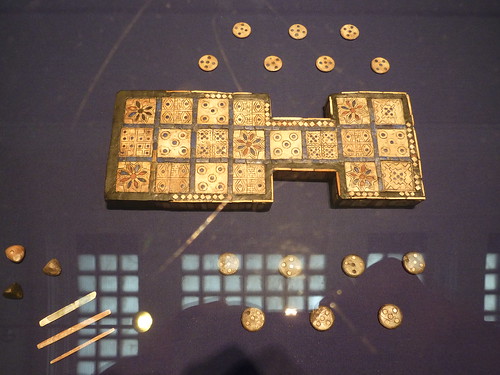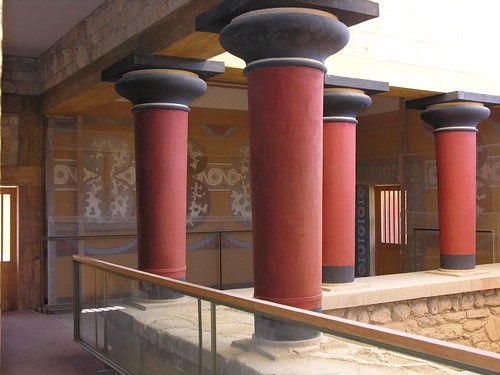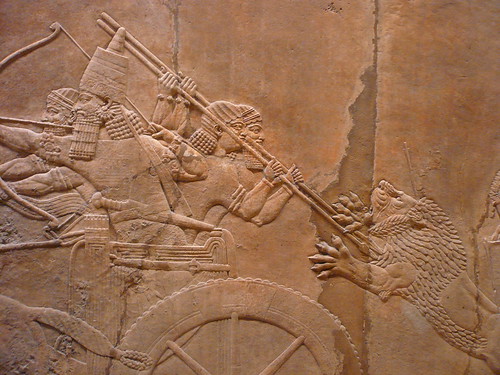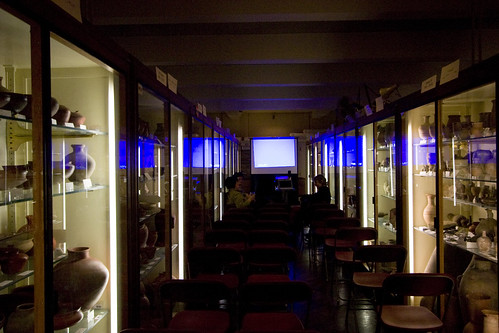Fearless globetrotters or carpetbagging looters? Whatever your opinion, Britain’s adventurers during the Age of Exploration, from the opening of the world’s first museum in Oxford to the King Tut tomb raid, changed ancient history forever. The Ancient World in London is reaching its climax, and over the course of our video series I’ve seen most of the city’s stunning treasures, from the Knidos Lion to the Assyrian Lion Hunt. So here’s a top ten greatest Age of Exploration personalities. If you think I’ve done well, or if you think I’m more inept than a boxer’s tear ducts, have your say in the comments box below.
10. Lord Elgin
Thomas Bruce, 7th Earl of Elgin and 11th Earl of Kincardine, as his name suggests, wasn’t short of a few pennies. So when, as a diplomat to the Ottoman Empire in 1801, Elgin was granted a firman of free access to the Parthenon and its sculptures, he wasted no time in taking them from Athens to Britain, later selling them to the British Museum where they have become popularly known as the Elgin Marbles. Today the debate about the legality of Elgin’s actions rages fiercely still, especially with the recent opening of the New Acropolis Museum. At the time Elgin claimed he was saving the Greek masterpieces from the indifference of the ruling Ottomans, an argument that holds considerable sway when you consider the Parthenon was being used as an arms depot. Yet there are many who feel that taking hundreds of ancient Greece’s greatest treasures is a step too far.
9. Amelia Edwards
Amelia Edwards represents so much about the Age of Exploration. A talented writer from the tender age of seven, she led the suffragette movement back in Britain whilst founding two of the nation’s most important archaeological societies. Fascinated from a young age by ancient Egypt Edwards set off for Cairo, without male company, in 1873 aged 42. She would soon witness the glamour and history of the Nile, chronicling her adventures in a number of books including A Thousand Miles up the Nile, in 1877.
Edwards became distressed at the lack of care given to Egypt’s ancient monuments, some of which she had had a hand in excavating such as the temple of Ramesses II at Abu Simbel. So in 1882 she brought together archaeologists like Flinders Petrie and Gaston Maspero to form the EEF Egypt Exploration Fund (now society). Her influence over the fund weakened over the following decade thanks in part to rows with the British Museum. Yet Edwards was keen to help still, and founded a new museum at University College, London, installing Flinders Petrie as its first professor, whose name the museum would later take. Edwards died later that year, yet her contribution to Egyptology is one of the most vital in history.
8. Charles Newton
 Newton’s name might not feature in many top ten lists of famous archaeologists, but his greatest discovery propels him rightly into the big-time. After working at the British Museum for over a decade, Newton spread his wings and became vice-consul at Mitylene, capital of the Greek island of Lesbos in 1852 and tasked with exploring the coasts of Asia Minor. After excavating at Knidos Newton stumbled across his greatest achievement in 1856-7 by discovering the remains of the Mausoleum at Halicarnassus, one of the seven wonders of the ancient world(play a seven wonders quiz here).
Newton’s name might not feature in many top ten lists of famous archaeologists, but his greatest discovery propels him rightly into the big-time. After working at the British Museum for over a decade, Newton spread his wings and became vice-consul at Mitylene, capital of the Greek island of Lesbos in 1852 and tasked with exploring the coasts of Asia Minor. After excavating at Knidos Newton stumbled across his greatest achievement in 1856-7 by discovering the remains of the Mausoleum at Halicarnassus, one of the seven wonders of the ancient world(play a seven wonders quiz here).
Newton’s later legacy would be played out back in Britain, where he had a key role in founding the Society for the Promotion of Hellenic Studies (known as the Hellenic Society), the British School at Athens and the Egypt Exploration Fund. Newton was later instated as professor of classical archaeology at University College, London for eight years between 1880 and 1888.
7. Leonard Woolley
Leonard Woolley is one of Mesopotamia’s greatest archaeologists, having excavated many of its most illustrious sites. Woolley became assistant keeper of the Ashmolean Museum in 1905, yet found his calling several years later when he teamed up with T.E. Lawrence, aka Lawrence of Arabia, to explore the Hittite city of Carchemish. Woolley’s adventurous life would then see him incarcerated as a POW in Turkey from 1916 – 18 during a British Museum expedition to Palestine. The BM and Penn Museum then commissioned Woolley for his greatest expedition, to the ancient Sumerian city of Ur in modern Iraq. Woolley excavated several royal cemeteries, the most glittering of which was that of Queen Pu-Abi. He took his bounty back to Britain, where most of it can be found in the British Museum.
Woolley soon had a knighthood under his belt, and shifted his sights to the Syrian city of Al-Mina, exploring links between the empires of the Aegean and Mediterranean Seas. A number of books then cemented his place in archaeological history, and Agatha Christie even based Murder in Mesopotamia on Woolley’s work.
6. Arthur Evans
Arthur Evans has to go down as a true great of archaeology: not only did he discover one of the most famous sites in ancient mythology, but he also rediscovered an entire civilization and its two languages. Evans was well educated in England before adventuring in Bosnia-Herzegovina in 1875, where he and his brother Lewis were imprisoned for making sketches in politically sensitive areas. 25 years later Evans would satisfy his love of travel and history when he purchased the archaeological site of Knossos in Crete. Evans had soon excavated the site’s famous palace, whose maze-like structure has led it to be suggested as the home of the mythological labyrinth in which King Minos held his deadly minotaur.
Evans concluded from Knossos that there must have been a culture on Crete even earlier than fellow great Heinrich Schliemann had claimed, creating the concept of the Minoan Civilization. And 3,000 tablets Evans excavated from the area became his next focus, as he began trying to decode their strange languages, which he noticed bore more than a passing resemblance to the Phoenician alphabet. These languages became Linear A and Linear B, great examples of which can be found in the Ashmolean Museum in Oxford.
5. Lord Carnarvon
Lord Carnarvon was a hedonistic English aristocrat who, amid his love for travel and fast cars, managed to spare a few moments to become one of Egyptology’s biggest names. Badly injured in a car crash in Germany, Carnarvon was ordered to eschew the cold winters of Britain for Cairo’s arid heat. But whilst in Egypt, he developed a taste for its history, and was soon spending his fortunes excavating some of the country’s greatest treasures.
It was Carnarvon’s meeting Howard Carter that changed his legacy in Egypt. Together the pair would form a close bond: Carter the avid archaeologist, Carnarvon the immeasurably wealthy adventurer. Carnarvon would fritter away his fortune in the desert, selling country manors (not Highclere Castle, mercifully) to fund houses for himself and Carter and an army of local workers. But the gamble paid off in 1922 when he and his friend discovered the tomb of Tutankhamun, the most famous archaeological breakthrough in history. Carnarvon would soon be dead, the victim of the ‘Curse of the Mummy’, aka a mosquito bite. Yet his posterity was secured: Lord Carnarvon was the epitome of an English adventurer.
4. Austen Henry Layard
Another gallavanting eccentric, it seems Henry Layard was born to live out a dramatic life. His family were immensely rich and powerful, allowing young Henry a platform to pursue his passion for travel and culture. He studied in Italy, France, England and Switzerland before qualifying as an attorney in 1839, aged 22. Layard wasn’t overly interested in law though, and trapsed off towards Ceylon, modern Sri Lanka, where he could use his father’s contacts to get a job working for the civil service. YetLayard’s love of ancient history got the better of him, and he spent several years exploring the Near East with friend Edward Mitford. Soon the pair had reached the Iraqi city of Mosul, where Layard noticed a suspiciously man-made protrusion coming from a mound.
Work in Constantinople followed, yet Layard could not take his mind off the mound and convinced diplomat Sir Stratford Canning to fund a Mosul excavation in 1845. Canning’s gamble paid off asLayard pulled hundreds of reliefs, statues and other treasures from the site, which he would later announce as the ancient Assyrian city of Nimrud. Layard’s name was made, and subsequent missions saw him unearth the fabled Assyrian capital Nineveh, where he found the amazing Lion Hunt reliefs. Every find was recorded in minute detail with accompanying line drawings, and later work for the British Museum saw Layard trying to decipher cuneiform, the first ever written language.
3. Howard Carter
It’s difficult to think Carter without mentioning Tutankhamun, and it’s admittedly thanks to the discovery of the boy king’s tomb in November 1922 that Howard Carter makes it so high up this list. But there was much more to the man than KV62: Carter had been an archaeologist for over 30 years before his fateful collaboration with Lord Carnarvon. Carter began his career in Egypt in 1891 aged just 17 as a tracer and artist for the EEF, drafted in primarily to draw animal images found on tombs. Yet his reputation for a studious individual soon saw him one of Flinders Petrie’s apprentices at Amarna, learning the skills of the trade and discovering the wonder of ancient Egypt.
By 1899 Carter has become First Chief Inspector General of Monuments for Upper Egypt, a title given by the Director of the Egyptian Antiquities Service, Gaston Maspero. Yet this position lasted only a short while, and Carter found himself frozen out of affairs after an incident with a drunken French tourist. Carter’s career was in tatters, and he made a living drawing pictures for tourists on the Nile. It wouldn’t be for another decade until Maspero introduced Carter to Carnarvon and the Tutankhamun saga began, ending in the greatest discovery of all time. The rest, as they say, is history, and Carter died in London a hero in 1939.
2. William Matthew Flinders Petrie
Yes, the ‘Father of modern Archaeology’ only makes it to second on my list; roll on the dissent. Flinders Petrie, born in Charlton in 1853, was afforded a good education and from an early age thought logically and meticulously about his interests. Upon hearing the Brading Roman Villa had been excavated with shovels, Petrie was horrified and vowed to install his own methodology to archaeology. His sights were turned first to Stonehenge, then to the famous Giza Plateau, where Petrie became the first person to properly record the pyramids’ geometry and study minute details to explore how they were built.
His reputation already growing, Petrie set out for the delta city of Tanis, where Amelia Edwards and the Egypt Exploration Fund allowed him 170 workmen. Petrie didn’t disappoint, and though he didn’t make any huge discoveries his precise methodology allowed him to recover thousands of smaller everyday items, which would have likely been lost otherwise. Further groundbreaking work was carried out at Sehel, Fayum and Palestine until Petrie made arguably his greatest discovery: that of the Merneptah Stele, aka the Israel Stele, at Luxor. It is the oldest mention of Israel by far, and proves Israel was a culture over 3,000 years ago. Petrie may not have made the same headline-grabbing finds as his contemporaries, but his acute way of working revolutionalised archaeology, and made people interested in the daily life of ancient Egypt.
1. Giovanni Battista Belzoni
 You might wonder why a circus strongman-cum-archaeologist who graffitied his name on Egypt’s greatest landmarks is ahead of all these famous names. But read that sentence back and I’m confident you’ll agree with me: Giovanni Belzoni is one of archaeology’s oddest characters, and his life story needs no hyperbole.
You might wonder why a circus strongman-cum-archaeologist who graffitied his name on Egypt’s greatest landmarks is ahead of all these famous names. But read that sentence back and I’m confident you’ll agree with me: Giovanni Belzoni is one of archaeology’s oddest characters, and his life story needs no hyperbole.
Ok hold your breath: Belzoni was born in Padua in 1778, yet left home for a monastic order in Rome aged 16. But to avoid arrest after a revolution in Italy he fled first to the Netherlands, then to England in 1803 where he met his wife Sarah Bane. At 6ft 7inches Belzoni found work in London as a circus strongman, named the ‘Patagonian Samson’, before working for antiquarian Henry Salt moving objects in Spain, Portugal and Sicily. Belzoni became obsessed with ancient culture, and after meeting an Ottoman emissary in Malta, travelled to Egypt where he met Salt again, who employed him to remove artefacts like the Colossal Bust of Ramesses II. Yet Belzoni wanted to make discoveries himself and began excavating.
It was at this time that Belzoni, now enamored with Egypt and growing his beard and wearing local clothing, made his biggest discovery: the tomb of Seti I, with its sarcophagus. The tomb is one of Thebes’ most beautiful, and the sarcophagus would eventually make its way to London’s Soane Museum. Belzoni continued to work as both an archaeologist and a ‘fixer’ in Egypt, helping to bring monuments like Cleopatra’s Needle to London. His second great discovery was the inner chambers of the Pyramid of Khafre at Giza, in which he wrote his name in huge lettering. Belzoni’s life of adventure came to an end in Benin in 1823, after a terminal case of dysentry. Yet his legacy remains in the hundreds of great artefacts he brought to the west. Do you still not think he should top this list?
HD Video: Episode 11 – Age of Discovery
Click here to view the transcript of this video.



